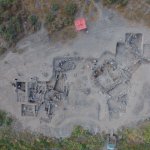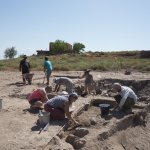The fifth season of the excavation was conducted from 30th of August to 30th of September. In the settlement, the strategy of the mission aimed to dig deeper at selected portions of the site to reach the earlier phases associated with the Urartian occupation of the „lower town”. While, in the cemetery a new kurgan (no. XIX) and its chamber was opened and explored. The members of the project were divided into six separate groups, five of these teams concentrated their work on the western and eastern part of the excavated portion of the settlement, while, the sixth team worked in the necropolis.
Team A worked mainly alongside the western wall of structure S2 in the area that was partially explored in 2014. Under the stone debris that covered the area a rectangular room (S11) was unearthed. The room was originally connected to structure S2 and it was probably abandoned at the same time. In the NE corner of the room a large in situ pithos was found. The upper part of the pithos was destroyed, therefore, we can only estimate that its original height was around 1 m. It is noteworthy that in 2014 within the stone debris above the same pithos a skeleton of a young man was found. The unusual position of the body points towards the possibility that he died a sudden an violent death. Interestingly, in the SW corner of the same room another skeleton was found during the 2017 season. The human remains also belonged to a young man. He was buried in embryonal position with an iron knife and an iron sickle blade nearby his head. According to the anthropological analysis, the man probably lost his life suddenly and possibly during the same event as the individuals discovered in the 2014 season.
Team B focused on the same area, in the SW corner of the excavated portion of the site, as during the previous season. Their task was to reach the deeper layers to help to better understand the relation between wall 1020, structure S2 and a possible paved surface that was discovered at the end of the 2016 season in the same area. During their work, they uncovered a large section of this „pavement”, however, as of now no conclusion could be made of its exact nature or function. On the NW side of wall 1020 two consecutive layers of floor were unearthed separated by a thin layer of ash, which can be the result of either the isolated destruction of the structure or part of a larger event that resulted in the destruction of the whole site. Furthermore, segmented remains of architectural features were discovered in the SE corner of the area. These elements attest to the presence of a badly damaged structure in the area, however, no walls were unearthed that could be associated with this enigmatic building.
Team C excavated deeper inside structures S8 and S9 to reach the floor level. In structure S9, a clay, basin-shaped installation was found on the surface of the floor. Around the installation, which was filled by ash, five broken medium and small vessels were found. Together with them, we found a flat basalt quern and a clay bread stamp, which could indicate that the function of the installation was designated for food production. Similarly to structure S1, the team uncovered traces of ash on the floor level of S9, which could indicate that room was destroyed by fire.
Team D worked in the area north to structure S1 in squares B15 and C15. During their work, the team unearthed several badly preserved walls that most probably belong to the post-Urartian period. The second male skeleton of the 2017 season was found under one of these walls. He was buried in an unusual position without any grave goods aside from an iron sickle blade and personal ornaments: two bronze fibula, an iron pin and a bronze tweezer. The context, along with his unusual body position and his young age indicate that he lost his life during the same event as the individuals buried nearby structure S2. This supposition is further reinforced by the objects found nearby the body.
Team E focused its efforts only inside structure S7 that adjoins structure S1 from the south. The construction has two occupation phases marked by two clay floor levels. Unfortunately, we did not found any remains which could help us to determinate the function of the building. Originally the structure was connected to S1 by a passage that is located near the NE corner of S7. However, this passage was blocked in a subsequent phase. After the rearrangement, which can be dated roughly to the late Urartian period, structure S7 was abandoned and its ruins were used as a garbage dump.
The fieldwork in the cemetery revealed a multi-layered kurgan chamber (no. XIX) that contains multiple burials dated roughly in between the Late Bronze Age and the Urartian period (14th – 7th century B.C). Among the hundreds of stone beads, the most noteworthy finds are two gold objects, an elaborate pendant and a bead.
Team Members:
Krzysztof Jakubiak, Artavazd Zaqyan, Mateusz Iskra, Tigran Zaqyan, Marek Truszkowski, Hasmik Simonyan, Otto Bagi, Magdalena Bagi, Nerses Mamikonyan, Tatiana Adamowska, Menua Gevorgyan, Elisabeth Bastien, Lusine Aleqsanyan, Kornelia Kasperkiewicz, Levon Mkrtchyan, Dan Socaciu, Astghik Simonyan, Maciej Sobczak, Aleksandra Konrad, Kinga Bigoraj, Jerzy Ciastek, Ludmiła Krukowska, Jakub Gronowski, Małgorzata Reszka, Julia Maczuga, Deborah Gawlikowska, Zuzanna Wygnańska, Karol Zajdowski




